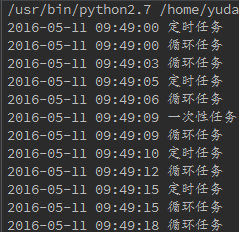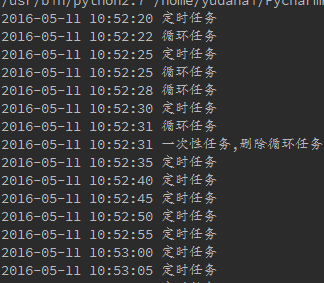apscheduler的使用
最近一个程序要用到后台定时任务,看了看python后台任务,一般2个选择,一个是apscheduler,一个celery。apscheduler比较直观简单一点,就选说说这个库吧。网上一搜索,晕死,好多写apscheduler的都是超级老的版本,而且博客之间相互乱抄,错误一大堆。还是自己读官方文档,为大家理一遍吧。
先安装一下吧,最新版本的apscheduler是3.0.5版
- 安装
pip install apscheduler

安装完毕
2. 简单任务
首先,来个最简单的例子,看看它的威力。
# coding:utf-8
from apscheduler.schedulers.blocking import BlockingScheduler
import datetime def aps_test():
print datetime.datetime.now().strftime('%Y-%m-%d %H:%M:%S'), '你好' scheduler = BlockingScheduler()
scheduler.add_job(func=aps_test, trigger='cron', second='*/5')
scheduler.start()
看代码,定义一个函数,然后定义一个scheduler类型,添加一个job,然后执行,就可以了,代码是不是超级简单,而且非常清晰。看看结果吧。

5秒整倍数,就执行这个函数,是不是超级超级简单?对了,apscheduler就是通俗易懂。
再写一个带参数的。
# coding:utf-8
from apscheduler.schedulers.blocking import BlockingScheduler
import datetime def aps_test(x):
print datetime.datetime.now().strftime('%Y-%m-%d %H:%M:%S'), x scheduler = BlockingScheduler()
scheduler.add_job(func=aps_test, args=('你好',), trigger='cron', second='*/5')
scheduler.start()
结果跟上面一样的。
好了,上面只是给大家看的小例子,我们先从头到位梳理一遍吧。apscheduler分为4个模块,分别是Triggers,Job stores,Executors,Schedulers.从上面的例子我们就可以看出来了,triggers就是触发器,上面的代码中,用了cron,其实还有其他触发器,看看它的源码解释。
The ``trigger`` argument can either be:
#. the alias name of the trigger (e.g. ``date``, ``interval`` or ``cron``), in which case any extra keyword
arguments to this method are passed on to the trigger's constructor
#. an instance of a trigger class
看见没有,源码中解释说,有date, interval, cron可供选择,其实看字面意思也可以知道,date表示具体的一次性任务,interval表示循环任务,cron表示定时任务,好了,分别写个代码看看效果最明显。
# coding:utf-8
from apscheduler.schedulers.blocking import BlockingScheduler
import datetime def aps_test(x):
print datetime.datetime.now().strftime('%Y-%m-%d %H:%M:%S'), x scheduler = BlockingScheduler()
scheduler.add_job(func=aps_test, args=('定时任务',), trigger='cron', second='*/5')
scheduler.add_job(func=aps_test, args=('一次性任务',), next_run_time=datetime.datetime.now() + datetime.timedelta(seconds=12))
scheduler.add_job(func=aps_test, args=('循环任务',), trigger='interval', seconds=3) scheduler.start()
看看结果

其实应该不用我解释代码,大家也可以看出结果了,非常清晰。除了一次性任务,trigger是不要写的,直接定义next_run_time就可以了,关于date这部分,官网没有解释,但是去看看源码吧,看这行代码。
def _create_trigger(self, trigger, trigger_args):
if isinstance(trigger, BaseTrigger):
return trigger
elif trigger is None:
trigger = 'date'
elif not isinstance(trigger, six.string_types):
raise TypeError('Expected a trigger instance or string, got %s instead' % trigger.__class__.__name__) # Use the scheduler's time zone if nothing else is specified
trigger_args.setdefault('timezone', self.timezone) # Instantiate the trigger class
return self._create_plugin_instance('trigger', trigger, trigger_args)
第4行,如果trigger为None,直接定义trigger为'date'类型。其实弄到这里,大家应该自己拓展一下,如果实现web的异步任务。假设接到一个移动端任务,任务完成后,发送一个推送到移动端,用date类型的trigger完成可以做的很好。
3.日志
好了,scheduler的基本应用,我想大家已经会了,但这仅仅只是开始。如果代码有意外咋办?会阻断整个任务吗?如果我要计算密集型的任务咋办?下面有个代码,我们看看会发生什么情况。
# coding:utf-8
from apscheduler.schedulers.blocking import BlockingScheduler
import datetime def aps_test(x):
print 1/0
print datetime.datetime.now().strftime('%Y-%m-%d %H:%M:%S'), x scheduler = BlockingScheduler()
scheduler.add_job(func=aps_test, args=('定时任务',), trigger='cron', second='*/5') scheduler.start()
还是上面代码,但我们中间故意加了个错误,看看会发生什么情况。

说我们没有log文件,好吧,我们添加一个log文件,看看写的什么。
# coding:utf-8
from apscheduler.schedulers.blocking import BlockingScheduler
import datetime
import logging logging.basicConfig(level=logging.INFO,
format='%(asctime)s %(filename)s[line:%(lineno)d] %(levelname)s %(message)s',
datefmt='%Y-%m-%d %H:%M:%S',
filename='log1.txt',
filemode='a') def aps_test(x):
print 1/0
print datetime.datetime.now().strftime('%Y-%m-%d %H:%M:%S'), x scheduler = BlockingScheduler()
scheduler.add_job(func=aps_test, args=('定时任务',), trigger='cron', second='*/5')
scheduler._logger = logging
scheduler.start()

终于可以看到了,这时候才看到错误,这个是一定要注意的。
其实,到这里,完全可以执行大多数任务了,但我们为了效率,安全性,再往下面看看,还有什么。
4.删除任务
假设我们有个奇葩任务,要求执行一定阶段任务以后,删除某一个循环任务,其他任务照常进行。有如下代码:
# coding:utf-8
from apscheduler.schedulers.blocking import BlockingScheduler
import datetime
import logging logging.basicConfig(level=logging.INFO,
format='%(asctime)s %(filename)s[line:%(lineno)d] %(levelname)s %(message)s',
datefmt='%Y-%m-%d %H:%M:%S',
filename='log1.txt',
filemode='a') def aps_test(x):
print datetime.datetime.now().strftime('%Y-%m-%d %H:%M:%S'), x def aps_date(x):
scheduler.remove_job('interval_task')
print datetime.datetime.now().strftime('%Y-%m-%d %H:%M:%S'), x scheduler = BlockingScheduler()
scheduler.add_job(func=aps_test, args=('定时任务',), trigger='cron', second='*/5', id='cron_task')
scheduler.add_job(func=aps_date, args=('一次性任务,删除循环任务',), next_run_time=datetime.datetime.now() + datetime.timedelta(seconds=12), id='date_task')
scheduler.add_job(func=aps_test, args=('循环任务',), trigger='interval', seconds=3, id='interval_task')
scheduler._logger = logging scheduler.start()
看看结果,

在运行过程中,成功删除某一个任务,其实就是为每个任务定义一个id,然后remove_job这个id,是不是超级简单,直观?那还有什么呢?
5.停止任务,恢复任务
看看官方文档,还有pause_job, resume_job,用法跟remove_job一样,这边就不详细介绍了,就写个代码。
# coding:utf-8
from apscheduler.schedulers.blocking import BlockingScheduler
import datetime
import logging logging.basicConfig(level=logging.INFO,
format='%(asctime)s %(filename)s[line:%(lineno)d] %(levelname)s %(message)s',
datefmt='%Y-%m-%d %H:%M:%S',
filename='log1.txt',
filemode='a') def aps_test(x):
print datetime.datetime.now().strftime('%Y-%m-%d %H:%M:%S'), x def aps_pause(x):
scheduler.pause_job('interval_task')
print datetime.datetime.now().strftime('%Y-%m-%d %H:%M:%S'), x def aps_resume(x):
scheduler.resume_job('interval_task')
print datetime.datetime.now().strftime('%Y-%m-%d %H:%M:%S'), x scheduler = BlockingScheduler()
scheduler.add_job(func=aps_test, args=('定时任务',), trigger='cron', second='*/5', id='cron_task')
scheduler.add_job(func=aps_pause, args=('一次性任务,停止循环任务',), next_run_time=datetime.datetime.now() + datetime.timedelta(seconds=12), id='pause_task')
scheduler.add_job(func=aps_resume, args=('一次性任务,恢复循环任务',), next_run_time=datetime.datetime.now() + datetime.timedelta(seconds=24), id='resume_task')
scheduler.add_job(func=aps_test, args=('循环任务',), trigger='interval', seconds=3, id='interval_task')
scheduler._logger = logging scheduler.start()
看看结果

是不是很容易?好了,删除任务,停止任务,恢复任务就介绍到这,下面我们看看监听任务。
6.意外
任何代码都可能发生意外,关键是,发生意外了,如何第一时间知道,这才是公司最关心的,apscheduler已经为我们想到了这些。
看下面的代码,
# coding:utf-8
from apscheduler.schedulers.blocking import BlockingScheduler
from apscheduler.events import EVENT_JOB_EXECUTED, EVENT_JOB_ERROR
import datetime
import logging logging.basicConfig(level=logging.INFO,
format='%(asctime)s %(filename)s[line:%(lineno)d] %(levelname)s %(message)s',
datefmt='%Y-%m-%d %H:%M:%S',
filename='log1.txt',
filemode='a') def aps_test(x):
print datetime.datetime.now().strftime('%Y-%m-%d %H:%M:%S'), x def date_test(x):
print datetime.datetime.now().strftime('%Y-%m-%d %H:%M:%S'), x
print 1/0 def my_listener(event):
if event.exception:
print '任务出错了!!!!!!'
else:
print '任务照常运行...' scheduler = BlockingScheduler()
scheduler.add_job(func=date_test, args=('一定性任务,会出错',), next_run_time=datetime.datetime.now() + datetime.timedelta(seconds=15), id='date_task')
scheduler.add_job(func=aps_test, args=('循环任务',), trigger='interval', seconds=3, id='interval_task')
scheduler.add_listener(my_listener, EVENT_JOB_EXECUTED | EVENT_JOB_ERROR)
scheduler._logger = logging scheduler.start()
看看结果

是不是很直观,在生产环境中,你可以把出错信息换成发送一封邮件或者发送一个短信,这样定时任务出错就可以立马就知道了。
好了,今天就讲到这,以后我们有机会再来拓展这个apscheduler,这个非常强大而且直观的后台任务库。
apscheduler的使用的更多相关文章
- Python任务调度模块 – APScheduler
APScheduler是一个Python定时任务框架,使用起来十分方便.提供了基于日期.固定时间间隔以及crontab类型的任务,并且可以持久化任务.并以daemon方式运行应用.目前最新版本为3.0 ...
- python3使用pyinstaller打包apscheduler出的错
本来只是想用Python做一个定时任务小工具在服务器上运行,可是服务器在隔离区,各种禁止上外网,使用pip导出列表那种下载库的方法不管用,导致Python的各种库都下不到,官网离线下载又各种缺依赖,好 ...
- Python定时任务框架APScheduler 3.0.3 Cron示例
APScheduler是基于Quartz的一个Python定时任务框架,实现了Quartz的所有功能,使用起来十分方便.提供了基于日期.固定时间间隔以及crontab类型的任务,并且可以持久化任务.基 ...
- apscheduler 绿色版
由于依赖EntryPoint,因此apscheduler在离线的方式(直接拷贝然后引用)使用时,会报错. 错误信息类似: No trigger by the name “interval/cron/d ...
- apscheduler 排程
https://apscheduler.readthedocs.org/en/v2.1.2/cronschedule.html 参数 说明 year 4位年 month 月份1-12 day 日:1- ...
- APScheduler —— Python化的Cron
APScheduler全程为Advanced Python Scheduler,是一款轻量级的Python任务调度框架.它允许你像Cron那样安排定期执行的任务,并且支持Python函数或任意可调用的 ...
- 定时任务框架APScheduler学习详解
APScheduler简介 在平常的工作中几乎有一半的功能模块都需要定时任务来推动,例如项目中有一个定时统计程序,定时爬出网站的URL程序,定时检测钓鱼网站的程序等等,都涉及到了关于定时任务的问题,第 ...
- django-xadmin中APScheduler的启动初始化
环境: python3.5.x + django1.9.x + xadmin-for-python3 APScheduler做为一个轻量级和使用量很多的后台任务计划(scheduler)包,可以方便 ...
- flask+apscheduler+redis实现定时任务持久化
在我们开发flask的时候,我们会结合apscheduler实现定时任务,我们部署到服务器上,会不会遇到这样的问题,每次我们部署后,我们重启服务后,原来的定时任务都需要重启,这样对我们经常迭代的项目肯 ...
随机推荐
- 转:为什么需要htons(), ntohl(), ntohs(),htons() 函数
为什么需要htons(), ntohl(), ntohs(),htons() 函数: 在C/C++写网络程序的时候,往往会遇到字节的网络顺序和主机顺序的问题.这是就可能用到htons(), ntohl ...
- github使用入门 之GIT GUI Windows版
申明下是原创. 这二天网上也看了不少关于github使用的文章,github对代码管理也开始用起来了.这篇给github新手看,大牛们请跳过. github说白了就是版本管理库,最常用的就是程序代码管 ...
- iOS 9之分屏多任务(Split View)
金田(github 示例源码) 多任务(multitasking)算是iOS9中最引人瞩目的核心新特性了,之前越狱版用户就用过类似的插件,微软的 苏菲 (Windows Surface)系列也有分屏多 ...
- 【转】secureCRT使用退格键(backspace)出现^H解决办法
原文网址:http://skykiss.blog.51cto.com/blog/2892603/769771 原创作品,允许转载,转载时请务必以超链接形式标明文章 原始出处 .作者信息和本声明.否则将 ...
- HDOJ(HDU) 1555 How many days?(水题)
Problem Description 8600的手机每天消费1元,每消费K元就可以获赠1元,一开始8600有M元,问最多可以用多少天? Input 输入包括多个测试实例.每个测试实例包括2个整数M, ...
- HDU_2033——时间加法
Problem Description HDOJ上面已经有10来道A+B的题目了,相信这些题目曾经是大家的最爱,希望今天的这个A+B能给大家带来好运,也希望这个题目能唤起大家对ACM曾经的热爱.这个题 ...
- python部落刷题宝学到的内置函数(二)
感觉到刷题宝有一个好处,也许也不是好处,它的答案必须是真正输出的值,也就是说应该输出字符串aaaa的时候,答案必须写成界面上返回的值,即'aaaa'.有利于真正记忆返回值类型,但是....太繁琐了 1 ...
- S-Nim
http://acm.hdu.edu.cn/showproblem.php?pid=1536 SG经典题,不多说 // File Name: hdu1536.cpp // Author: bo_jwo ...
- iOS之UITableView带滑动操作菜单的Cell
制作一个可以滑动操作的 Table View Cell 本文翻译自 http://www.raywenderlich.com/62435/make-swipeable-table-view-cell- ...
- zabbix流量汇聚
"服务器流量汇总"领导提需求,要把几个数据中心的数据汇总起来,于是就google了一下"zabbix流量汇总" 按照其中一篇博客做了出来,博客地址如下. htt ...
